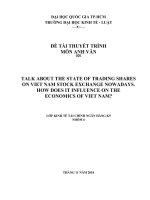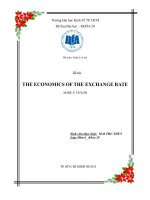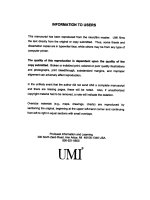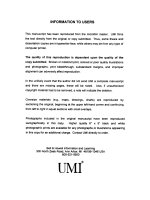Lecture Macroeconomics (19/e) - Chapter 22: The economics of developing countries
Bạn đang xem bản rút gọn của tài liệu. Xem và tải ngay bản đầy đủ của tài liệu tại đây (520.76 KB, 16 trang )
22W
The Economics of Developing
Countries
McGrawHill/Irwin
Copyright © 2012 by The McGrawHill Companies, Inc. All rights reserved.
Classifications
• Industrially advanced countries
• High income nations
• Well-developed market economies
• Per capita income $37,665 in 2008
• Developing countries
• Middle income nations
• Low income nations
• Wide variation in income per capita
LO1
22W-2
Classifications
22W-3
Comparisons
• U.S. GDP $14.6 trillion
• Combined GDP of DVCs $15.6 trillion
• U.S. has 4.5% of population but
•
•
LO1
produces 25.1% of world’s output
U.S. per capita GDP is 150 times that
of Sierra Leone
Walmart’s annual revenue is greater
than all but 23 nations’ GDP
22W-4
Growth, Decline and Income Gaps
• Some developing countries have
•
•
LO1
grown considerably
• China, Malaysia, Chile, Thailand
Some developing countries have
become high-income
• Singapore, Greece, Hong Kong
Income gap has widened
• Developing countries must grow
faster to reduce the gap
22W-5
Human Realities of Poverty
Selected Socioeconomic Indicators of Development
LO2
22W-6
Obstacles to Development
• The path to economic development
• Use existing resources more
•
LO2
efficiently
• Expand available supplies of
resources
Simple generalizations are not
possible
22W-7
Obstacles to Development
•
LO2
Natural Resources
• Shortage of land, resources,
power
• Tropical climates hinder labor,
lead to disease
• Difficult to solve
22W-8
Obstacles to Development
• Human resources
• Large populations
• Reduced standard of living
• Less saving and investment
• Lower productivity
• Overuse of land resources
• Urban problems
• Qualifications
• Unemployment and underemployment
LO2
22W-9
Obstacles to Development
• Capital accumulation
• This is key for economic
development
• Domestic capital formation
• Savings potential
• Capital flight
• Investment obstacles
• Lack of infrastructure
LO2
22W-10
Obstacles to Development
• Technological advance
• Borrowed technology
• Socio-cultural obstacles
• Institutional obstacles
• Land reform
LO2
22W-11
The Vicious Circle of Poverty
LOW
PER CAPITA
INCOME
LOW
PRODUCTIVITY
RAPID
POPULATION
GROWTH
LOW LEVEL
OF SAVING
LOW LEVEL
OF DEMAND
LOW LEVELS OF
INVESTMENT IN
PHYSICAL AND
HUMAN CAPITAL
LO3
22W-12
Role of Government
• A positive role
• Establishing the rule of law
• Building infrastructure
• Embracing globalization
• Building human capital
• Promoting entrepreneurship
• Developing credit systems
• Controlling population growth
• Making peace with neighbors
LO4
22W-13
Role of Government
• Public sector problems
• Misadministration
• Bribery
• Corruption
LO4
22W-14
Role of Government
LO4
22W-15
Role of Advanced Nations
• Expanding trade
• Admitting temporary workers
• Discouraging arms sales
• Foreign aid
• Direct aid
• The World Bank group
LO5
22W-16









